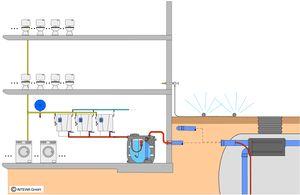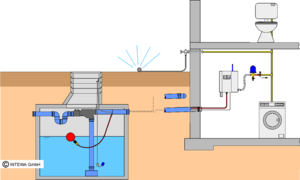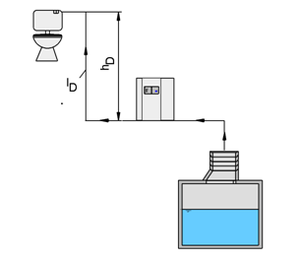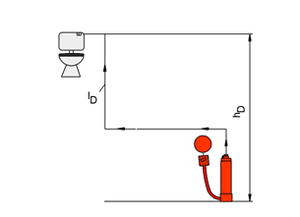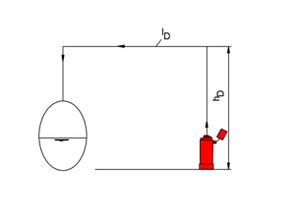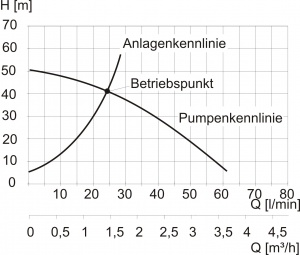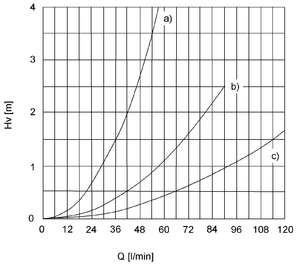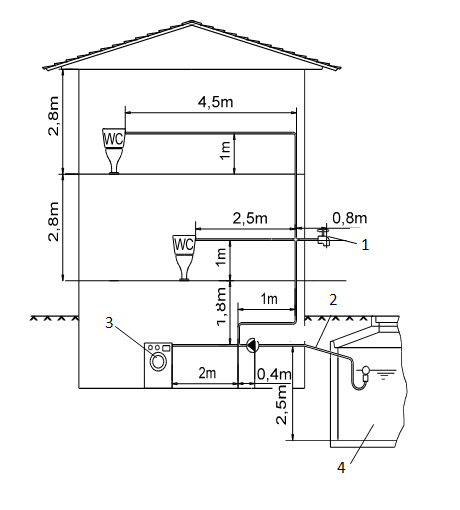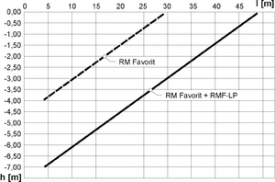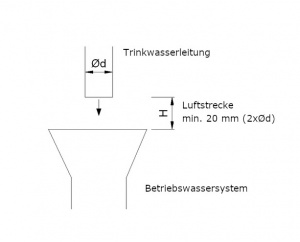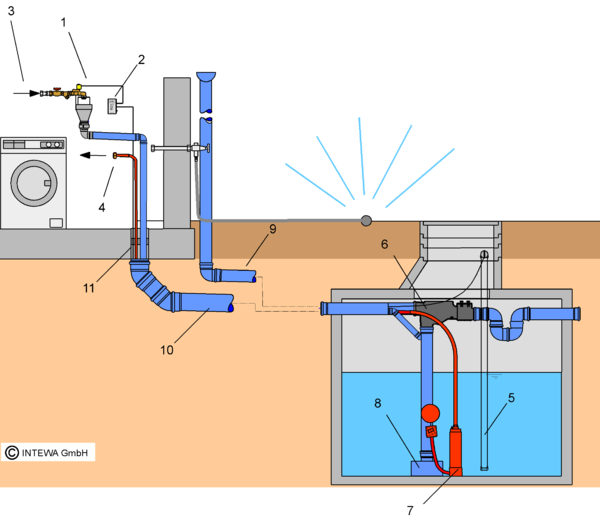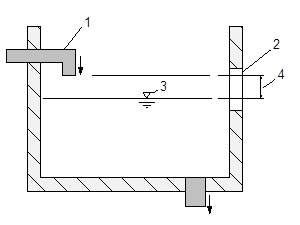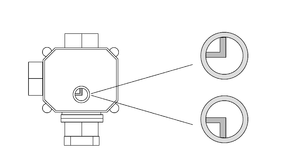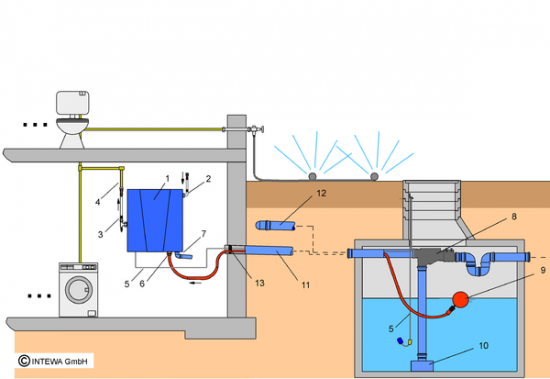Pumpen, Betriebs- und Regenwasserwerke/en: Unterschied zwischen den Versionen
(Die Seite wurde neu angelegt: „600px|Air gap in the cistern“) |
(Die Seite wurde neu angelegt: „{| class="wikitable" |- | 1. Supplemental supply unit for drinking water backup || 7. Submersible pump with integrated controller and SAUGSAGF suction filter |…“) |
||
| Zeile 381: | Zeile 381: | ||
{| class="wikitable" | {| class="wikitable" | ||
|- | |- | ||
| − | | 1. | + | | 1. Supplemental supply unit for drinking water backup || 7. Submersible pump with integrated controller and SAUGSAGF suction filter |
|- | |- | ||
| − | | 2. RAINMASTER D 24|| 8. | + | | 2. RAINMASTER D 24|| 8. Inlet calmer |
|- | |- | ||
| − | | 3. | + | | 3. Drinking water connection || 9. Rainwater inlet pipe |
|- | |- | ||
| − | | 4. | + | | 4. Pressure pipe to the fixtures|| 10. Protective conduit for pressure pipe, drinking water backup and RMD |
|- | |- | ||
| − | | 5. | + | | 5. Sensor cable for capacitive level measurement || 11. MD150 wall bushing |
|- | |- | ||
| − | | 6. | + | | 6. PURAIN rainwater filter || |
|} | |} | ||
Version vom 11. Oktober 2018, 13:11 Uhr
Non-potable water centres, also known as operation and monitoring centres, domestic water systems, non-potable water systems, rainwater units or rainwater centres, are ready-to-connect devices for the non-potable water supply, consisting of integrated pump, controller and drinking water backup.
Types of pumps
=Diaphragm pumps for single-family house
Diaphragm pumps are an independent type of displacement pump, which are used in several fields, e.g. in family houses with small gardens. An elastic diaphragm is moved up and down by a piston. During the downward stroke the liquid is sucked through the inlet valve. During the upward stroke, the diaphragm presses the fluid out through the outlet valve from the pump head. The pumping cylinder is hermetically separated from the pump drive by the diaphragm. This means that diaphragm pump supplies uncontaminated fluid. Thus, all essential water fixtures can be sufficiently supplied in a single-family house by using very small pumps with very small flow rates. Due to the huge benefits in energy consumption and performance, suction characteristics and especially low noise level, these pumps are increasingly used in the single-family house applications, e.g. in the domestic water unit, RAINMASTER Eco. The optimum range of all fixtures in a single-family house falls very close to the pump characteristic curve. In contrast, for centrifugal pumps, which are currently used for rainwater harvesting, the usual operating points are very far from the characteristic curve (see diagram). This implies unnecessary power consumption in virtually all operating conditions of the centrifugal pump. The diaphragm pump, selected for rainwater harvesting or greywater recycling, ensures a maximum pressure of 3.5 bar and a maximum flow rate of 10 L / min. This is not only sufficient for most applications in a single-family house, but also offers an ideal performance range. For the most commonly used fixtures, e.g. toilet flushing, even 1 bar and 5 L / min is actually sufficient (see diagram). If several fixtures are simultaneously opened, then this results simply in a longer filling time for the fixture.
"""Comparison of pump curves for diaphragm and centrifugal pump"""

| Q: | Flow rate [L/min] | Operating point, toilet | ∎ |
| H: | Pressure head loss [m] | Operating point, washing machine: | ● |
| Centrifugal pump (multi-stage): | Blue | Operating point, 10 m garden hose: | ▲ |
| Diaphragm pump: | Magenta | Operating point, garden faucet: | + |
The flow rate is largely independent of pressure loss in the pressure pipe (see characteristic curves) due to the mode of operation of the pump (displacement principle). With a garden hose for instance, this does not lead to a sharp decrease in the flow rate i.e. with a centrifugal pump.
Multi-stage suction pumps for medium-sized commercial systems
With water reuse applications, high-quality, corrosion-free multi-stage centrifugal pumps should be used. Meanwhile, multi-stage pumps with noise levels of ca. 65 dbA or less are available. Such domestic water units (non-potable water systems) e.g. RAINMASTER Favorit are integrated with drinking water backup and control in a single device. These units can self-prime to 15 m with a suction height of 3 m and are suitable for supplying all fixtures in medium-sized commercial or single-family houses with large gardens without an extra charging pump.
Multi-stage submersible pumps purely for garden irrigation
Submersible pumps with integrated control are suitable for using rainwater for garden irrigation. The pressure pipe can be installed directly from the tank to the garden faucet. Drinking water breakup in this case is direct into the cistern, e.g. with a RAINMASTER D. Here the submersible pump produces no noise and since it requires no space in an installation room, they can be used in construction projects where there is no space for a domestic water unit. Additionally the distance between the cistern and the installation room plays no role with the submersible pump. Since these pumps are installed in the cistern and are in constant water contact, they are exposed to difficult external conditions. Therefore they should be completely made of stainless steel and corrosion-resistant plastic. To protect the drive motor, double shaft seals should be used.
Multiple pumping system
With larger systems (office buildings, industry, large apartment buildings, etc.) several domestic water units can be operated in parallel. This has the following advantages:
- higher security of supply especially with redundant operation as with e.g. the RAINMASTER Favorit SC
- Minimizing power consumption
- Increasing operational lifetime
In larger systems the distance from the storage tank is often too far for direct suction. Therefore a submersible pump first supplies the water to a hybrid tank (intermediate tank). The domestic water units then suction from the hybrid tank.
Immersion pumps for drainage
If the drainage of tanks or individual fixtures in the house to sewage by direct connection is not possible, then an immersion pump is used. These "lift" excess water above the backwater level to the appropriate drainage system. The pumps are characterized by the use of very high-quality materials and can also pump coarse debris depending on the type. These pumps are controlled by float switches, which detect the water level and also implement the necessary protection to prevent dry-running of the pump. Immersion pumps can also be used as charging pumps for suction pumps if the suction performance of the pump is not high enough.
Dimensioning for pumps
See also [Online Planner]
Diaphragm pump in a domestic water system
Quick dimensioning for the operating point of the diaphragm pump:
Determining the total flow rate QR of the system:
Number of cistern flush toilets 2 * 8 L/min = 16 L/min Number of water taps 1 * 18 L/min = 18 L/min Number of washing machines 1 * 15 L/ min = 15 L/ min QR 49 L/ min
The actual maximum flow rate is calculated as:
- QSP = 0.1 x QR = 4.9 L/min
0.1 = Simultaneity factor. See 2.5.2
The operating water supply for the single-family residential area in a special case. Here the recommendations from DIN 1988, part 3 <ref name="DIN1988">DIN 1988 Teil 3 u. 5</ref> (German regulation) are difficult to grasp. In practice, calculated values for the simultaneity factor that correspond to between 0.1 and 0.2 have proven successful. The common fixtures like toilets, washing machines, garden taps and high-pressure cleaners will also be supplied together assuming a slightly longer filling time.
- Hges = hD + 16 m = 6 m + 16m = 22 m = 2.2 bar
In order to supply the fixture with a water pressure of at least 1.6 bar, a 16 m water column is specified in the formula.
Suction: The suction length of the diaphragm pump is also physically limited. Due to the low flow speed there is however a respectively low loss coefficient. Therefore with a suction height of up to 2 m a suction length of 40 m is possible. If the suction performance is not enough, a charging pump can be installed on the suction pipe. Example dimensioning.
Multi-stage suction pump in a domestic water system
The domestic water unit is installed in the basement or installation room of the house and therefore easily accessible and controllable. The pump suctions water out of the tank and subsequently pumps it to the appropriate fixtures.
Quick dimensioning for the operating point of the centrifugal pump:
Determining the total flow rate Qr of the system:
Number of cistern flush toilets _ _ _ * 8 L/min = _ _ _ L/min Number of water taps _ _ _ * 18 L/min = _ _ _ L/min Number of washing machines _ _ _ * 15 L/ min = _ _ _ L/ min QR _ _ _ L/ min
The actual maximum flow rate is calculated as:
- QSP = 0.7 x QR = _ _ _ L/min
The approximate required pumping head is:
- Hges = hD + lD x 0.2 +16 m = _ _ _ m
(Losses in the suction line are included here)
Result: Operating point of the suction pump: (QSP, Hges) This point must lie below or on the pump curve.
Suction
The suction length of the pumps is physically limited. Therefore with a suction height of up to 2 m a suction length of 16 m is possible. If the suction performance is not enough, a charging pump can be installed on the suction pipe or it can be operated with a hybrid system. Example dimensioning.
Multi-stage submersible pumps
These pumps do not need suction; rather they directly supply water to fixtures in the house from the tank.
Quick dimensioning:
An exact dimensioning can be done with the RAINPLANER software. Determining the total flow rate QR of the system:
Number of cistern flush toilets _ _ _ * 8 L/min = _ _ _ L/min Number of water taps _ _ _ * 18 L/min = _ _ _ L/min Number of washing machines _ _ _ * 15 L/ min = _ _ _ L/ min QR _ _ _ L/ min
The actual maximum flow rate is calculated as:
- QSP = 0.7 x QR = _ _ _ L/min
The approximate required pumping head is:
- Hges = hD + lD x 0.2 + 16 m = _ _ _ m
(Losses in the suction line are included here)
Immersion pumps for drainage
Dimensioning as a lift pump is done according to DIN 1986-100<ref name="DIN1986">DIN 1986-100</ref> with a rainfall duration and return period r(5,100).
Quick dimensioning with r(5,100) according to DIN 1986-100:
Determining the associated total flow rates QR:
- QR = connected areas (m2) x (L/s ha) x 0.006 = _ _ _ L/min
The approximate required pumping head is:
- Hges = hD + lD x 0.2 = _ _ _ m
The pipe installed should correspond to the pump connection and should be of PE pipe or EPDM rubber hose with steel coil for direct burial. A check valve (non-return valve) should be installed in the pressure line.
Result: Operating point of the immersion pump: (QR, Hges)
This point must lie below or on the pump curve.
Precise pump dimensioning
Often a detailed dimensioning of the pump can be avoided with help from the quick dimensioning. When in doubt, the required pumping capacity should be determined more accurately. For this purpose, the following steps explain the selection of a suitable pump according to DIN 1988, Part 3 and 5. The required pumping capacity depends on the type of supplied fixture as well as the piping system. The pump must provide the calculated flow rate, Q, at the necessary pressure, herein described as discharge head, H. The flow rate results from the operating values of the fixtures, which should be simultaneously operated. The necessary pressure is composed of three parts:
- geodetic height (Hges)
- pressure loss in piping system (Hv)
- necessary operating pressure (flow pressure) of the fixtures (Hfl)
All possible operating points of a pump are shown on the operating characteristics curve (known as a pump curve or throttle curve) as a Q-H diagram, wherein the pressure is usually expressed as a meter water column (1 bar corresponds to approximately 10 m water column). The operating point of the pump is where the pump curve intersects the system characteristic curve. Each individual fixture has its own system characteristic curve together with the corresponding piping system. This also includes the system characteristic curve resulting from different combinations of fixtures. This results in various different operating points for the pump. In order to avoid calculating all system characteristic curves, the critical fixture demand is determined below, which must be optimally supplied even when several different fixtures are simultaneously operated. The operating point determined in this way should be close to, but below, the pump curve. The chosen pump should optimally supply the system without needing to be oversized and therefore consuming too much electricity.
Determining the theoretical maximum total discharge
The basis of pump dimensioning is determining the maximum required water flow. To calculate the total discharge the calculated flow rates (QR) of the individual fixtures are determined.
The total discharge therefore equals:
- ∑ QR = QR1 + QR2 + QR3 + ...
Calculated flow rates (QR) and minimum flow levels (Hfl) of selected fixtures (DIN 1988, Part 3)<ref name="DIN1988">DIN 1988 Teil 3 u. 5</ref>
| Rainwater fixtures | QR (L/min) | Hfl (L/min) | |
|---|---|---|---|
| Outlet valve | DN15 | 18 | 5 |
| Without aerator | DN20 | 30 | 5 |
| (Garden connection) | DN25* | 60 | 5 |
| Cistern flush toilet | 8 | 5 | |
| Pressure-flush for urinal | 18 | 10 | |
| Washing machine | 15 | 10 |
*only with intensive irrigation
Definition of the simultaneity factor
The larger the number of fixtures, the less likely it is that all fixtures will be used in simultaneous operation. Therefore, it is generally not sensible, due to ecological and economic reasons, to choose a pump that is capable of supplying simultaneously all extraction points. The relationship between the required maximum discharge of the pump (QSP) and the total discharge (∑QP) of the extraction points is called the simultaneity factor (f):
The simultaneity factor can therefore be selected smaller, the larger the number of extraction points there are. This allows the installation of smaller pumps with the smallest possible energy requirement, keeping costs low.
A special case is the supply of non-potable water to single family houses. Here, the recommendations from DIN 1988, Part 3<ref name="DIN1988">DIN 1988 Teil 3 u. 5</ref> are difficult to estimate. However, in practice, values that mathematically correspond to a simultaneity factor of between 0.1 and 0.2 are found. According to the definition of the simultaneity factor, f, the required maximum discharge of the pump (QSP) is obtained from the determined total discharge:
Therefore QSP may not fall below the maximum individual calculated flow rate QP of the fixtures; otherwise the function of these fixtures is impaired.
| Simultaneity factors for rainwater harvesting according to application | ||||
| Following DIN1988 part 3<ref name="DIN1988">DIN 1988 Teil 3 u. 5</ref> | Legend: 1 L/s corresponds as equivalent to ca. 8 WC | |||
| Total volume flow (L/s) | Residential */ Office / Administrative buildings factor (-) | Hotels / Hospitals factor (-) | Department stores factor (-) | Schools factor (-) |
|---|---|---|---|---|
| 0.8 | 0.60 | 0.60 | 0.60 | 1.00 |
| 1 | 0.55 | 0.40 | 0.60 | 1.00 |
| 5 | 0.25 | 0.29 | 0.29 | 0.68 |
| 10 | 0.18 | 0.21 | 0.21 | 0.48 |
| 15 | 0.14 | 0.17 | 0.17 | 0.38 |
| 20 | 0.13 | 0.15 | 0.15 | 0.32 |
| 25 | 0.11 | 0.14 | 0.15 | 0.28 |
| 30 | 0.10 | 0.14 | 0.14 | 0.25 |
- Special case single family house
An exception is non-potable water supply in single family houses. Here, the recommendations from DIN 1988, Part 3<ref name="DIN1988">DIN 1988 Teil 3 u. 5</ref> are difficult to estimate. However, in practice, values that mathematically correspond to a simultaneity factor of between 0.1 and 0.2 are found.
Calculating the total discharge head
The total discharge head is the height up to which water may still be supplied by the pump at the required maximum flow rate QSP. It can be separately calculated for each fixture. The largest value (usually the total discharge head of the geodetically highest fixture) is critical.
The total discharge head is made up of 3 parts:
- geodetic height of extraction point
- flow level of this fixture
- pressure lost due to friction in piping system and suction pipe
The geodetic height (Hgeo) is equal to the difference of height between the point of extraction and the lowest water level in the tank. The flow level (Hfl) corresponds to the pressure, which must be available in the fixture to ensure smooth functioning. The loss head (Hv) consists of the suction pipe portion (Hvs) [the pipe between pump and controller, in case of submersible pumps] together with the rest of the piping system in the house (Hvr):
- Hv = Hvs + Hvr
The friction loss in the suction pipe (Hvs) can be read from the diagram. Here, however, only the maximum discharge QSP is to be used in place of the total discharge ∑QR. The head loss in domestic piping (Hvr) is determined by the length of the pipe between the control unit and the fixture. With the usual combinations of flow rate and pipe diameter (e.g.: Q = 50 L / min, DN 25; Q = 27 L / min, DN 20; Q = 14 L / min, DN 15), there is an approximate loss of:
Therewith are the losses through elbows, valves, reducers and branches already accounted for (according to DIN 1988, Part 5)<ref name="DIN1988">DIN 1988 Teil 3 u. 5</ref>.
The total discharge head, which must be provided by the pump is calculated by:
- H = Hgeo + Hfl + Hv
For submersible and immersion pumps losses on the suction side are not applicable. As described above, the calculation of losses on the pressure side is done with the flow rates determined for these pumps.
Pump performance review
A suitable pump can be selected by the determined values for flow rate (QSP) and for discharge head (H) by means of various pump diagrams. If the calculated point (QSP/ H) lies below the pump characteristic curve, then the performance of the pump is sufficient.
Example: Pump dimensioning
Legend:
- Garden water tap
- 6 m long suction hose
- Washing machine
- Water tank
Determining the total flow rates according to DIN 1988 Part 3<ref name="DIN1988">DIN 1988 Teil 3 u. 5</ref> Table 11
Connected as fixtures to a rainwater system:
3 cistern flush toilets QR = 8 L/min 1 Washing machine QR = 15 L/min 1 Garden connection DN15 QR = 18 L/ min Total discharge: ∑QR 57 L/ min
Determining the simultaneity factor according to DIN 1988 Part 3<ref name="DIN1988">DIN 1988 Teil 3 u. 5</ref> Table 12
- Maximum discharge QSp = 29 L/min
Calculation of the total discharge head
The total discharge head is determined for the garden connection and upper cistern toilet:
Hgeo Hfl Hvr Hvs H Garden connection DN 15 5.3 5 5 x 0.2 0.18 x 6 + 0.5 12.9 m upper cistern toilet 8.1 5 11.5 x 0.2 0.18 x 6 + 0.5 17 m H = 17 m for the pump selection
Pump performance review
The determined dimensioning point is entered in the pump diagram:
- Qsp = 29 L/min ; H =17 m
Suction performance of the pump
With a suction pipe length of 6 m and a geodetic suction height of 2.5 m, the pump can be used without additional arrangements (such as a charging pump).
Controls
Pressure and flow control
The pumps are automatically controlled by pressure and flow dependent circuit-breakers that are installed in the pressure pipe after the pump. The essential function of preventing dry-running is best already integrated in the pump. With the domestic water units, these controllers are already integrated.
Speed control
With single pump systems and multi-pump systems an electronic control for speed regulation can be used. Modern speed-controllers regulate the speed of the pump depending on the pressure. Up to 40% of energy can be saved, e.g. with the RAINMASTER SC units. A speed-regulator increases the operating life of the pumps and reduces the running noise with low flow rates.
Drinking water backup
An essential component of most non-potable water systems is the automatic supply of fixtures with drinking water during times lacking rainfall (lack of non-potable water, e.g. greywater or rainwater). EN1717<ref name="DIN1717">DIN EN 1717</ref> and DIN 1989<ref name="DIN1989">DIN 1989-1</ref> (non-potable water systems) apply to drinking water backup systems as they prevent contamination of the drinking water with germs from greywater or rainwater. The following requirements must be fulfilled:
- The drinking water must be separated from the non-potable water by an „air-gap“ in order to prevent the backflow of contaminated water into the drinking water installation through a continuous unhindered free flow path. The distance from incoming drinking water and the max. possible water level on the non-potable side is defined as follows: H ≥ 2 x d (inlet of the drinking water pipe), otherwise min. 20 mm.
- Only the design forms type AA and AB “air-gap” are allowed according to EN1717<ref name="DIN1717">DIN EN 1717</ref>. Non-return valves (check valves), pipe splitters as well as pipe interrupters are not sufficient for separation and are therefore not allowed.
- Double connections on cistern flush toilets are not allowed.
- The “air-gap” must be installed as backwater safe.
In principle there are two forms of drinking water backup to decide from:
- Air-gap in the cistern
- Air-gap integrated in the non-potable water system (domestic water unit, commercial water centres)
Air gap in the cistern
In this variant the drinking water backup is directly supplied through the "air gap" into the water storage tank. The "air gap" is then best integrated in a ready-to-connect assembly with fixed distances according to DIN 1989<ref name="DIN1989">DIN 1989-1</ref> with stopcock, strainer and slow-closing solenoid valve and is directly connected to the drinking water pipe.
This form of drinking water backup is controlled e.g. by a RAINMASTER D. Due to the open pipe connection between the cistern and building the installation of the system must be considered with the backwater level from the sewer as well as cistern so that the backwater is prevented from entering the building. The "air-gap" for supplying drinking water must be at least 20 cm above the related backwater level, which is usually only the case when the system equipment is installed on the ground floor.
| 1. Supplemental supply unit for drinking water backup | 7. Submersible pump with integrated controller and SAUGSAGF suction filter |
| 2. RAINMASTER D 24 | 8. Inlet calmer |
| 3. Drinking water connection | 9. Rainwater inlet pipe |
| 4. Pressure pipe to the fixtures | 10. Protective conduit for pressure pipe, drinking water backup and RMD |
| 5. Sensor cable for capacitive level measurement | 11. MD150 wall bushing |
| 6. PURAIN rainwater filter |
Freier Auslauf in einer Betriebswasseranlage integriert
Bei speziellen Hauswasserwerken für die Betriebswassernutzung, wie z.B. der RAINMASTER Serie, ist der "Freie Auslauf“ nach der Trinkwassernorm DIN EN 1717<ref name="DIN1717">DIN EN 1717</ref> in Verbindung mit der neuen Ausführungs-Norm DIN EN 13077<ref name="DIN13077">DIN EN 13077</ref> bereits im Gerät integriert. Dies wird über einen integrierten Einspeisebehälter berücksichtigt. Dieser garantiert eine bedarfsgerechte Zuführung genau der Menge des gerade benötigten Trinkwassers, falls kein Betriebswasser (Regenwasser, Grauwasser oder sonstiges Betriebswasser) mehr zur Verfügung steht. Die Einhaltung der Norm muss durch eine anerkannte Prüfstelle zertifiziert sein (z.B. DVGW). Die Zertifizierung berücksichtigt auch die Prüfung auf Druckstoßverhalten und Trinkwasserverträglichkeit der Materialien (KTW-Prüfung).
Trinkwassernachspeiseeinrichtung (Typ AB) der RAINMASTER Serie gemäß DIN EN 1717<ref name="DIN1717">DIN EN 1717</ref>
| 1. Trinkwasserzulauf Nachspeisebehälter |
| 2. Überlauföffnung des Nachspeisebehälters |
| 3. Max. möglicher Wasserstand (bei Fehlfunktion) |
| 4. Freier Auslauf H zwischen Zulauf und max. möglichem Wasserstand = sichere Trennung von Trinkwasser und Betriebswasser |
Der 3-Wege Umschalthahn
Es sollte darauf geachtet werden, dass zur Umschaltung zwischen Betriebswasser und Trinkwasser in den Betriebswasseranlagen (Hauswasserwerken) ein motorgesteuerter 3-Wegehahn eingesetzt wird (keine Zonenventile). Nur so ist sicher gestellt, dass bei größeren Ansaugverlusten unfreiwillig aus dem Trinkwasserbehälter Wasser gezogen wird oder bei einem Aufbau unterhalb des Wasserspiegels des Speichers Betriebswasser in den Einspeisebehälter gedrückt wird.
| 1. Hauswasserwerk RAINMASTER Favorit | 8. Regenwasserfilter PURAIN |
| 2. Trinkwasseranschluss | 9. Schwimmende Ansauggarnitur |
| 3. Druckanschlussset | 10. Zulaufberuhigung |
| 4. Druckleitung zu den Verbrauchern | 11. Schutzrohr für Saugleitung und Sensorkabel |
| 5. Schwimmschalter | 12. Regenwasserzuleitung |
| 6. Saugleitung | 13. Mauerdurchführung MD-100 |
| 7. Notüberlauf |
Ausdehnungsgefäße
Bei großen Betriebswasseranlagen mit vielen Verbrauchern empfehlen sich auch größere Ausdehnungsgefäße alternativ oder zusätzlich zur Drehzahlsteuerung zur Stromeinsparung. Kleine Pumpen, wie z.B. die RM-Eco Pumpen können in Kombination mit einem großen Ausdehnungsgefäß als Pufferbehälter auch für größere Anlagen verwendet werden. Hierdurch kann eine besonders hohe energetische Effizienz und ein günstiges Preis-Leistungsverhältnis erreicht werden. .
Minimierung von Druckstößen
Bei schnell schließenden Verbrauchern empfiehlt sich der Einsatz von speziellen Ausdehnungsgefäßen mit Butylblase. Diese reduzieren Druckstöße und damit Geräusche, die ansonsten im Leitungssystem übertragen werden und sich dort durch Reflexion verstärken können. Die Druckausgleichsbehälter verringern durch ihr Puffervolumen zudem die Schalthäufigkeiten. Somit wird die Lebensdauer der Anlage erhöht.
Dimensionierung von Ausdehnungsgefäßen
Für eine grobe Bemessung der Gefäßgröße Vn kann folgende Berechnung verwendet werden:
| n | = | Pumpenanzahl |
| s | = | Schalthäufigkeit 20/h |
| QmaxA | = | Volumenstrom im Auslegungspunkt |
Beispiel: RAINMASTER Favorit 40
Auslegungspunkt: 2,5 bar bei 70 l/min = 4,2 m³/h
- Einsatz eines Behälters mit 150 Liter.
Aus Gründen der Energieeffizenz empfiehlt sich immer der Einbau des nächst größeren Ausdehnungsgefäßes.

